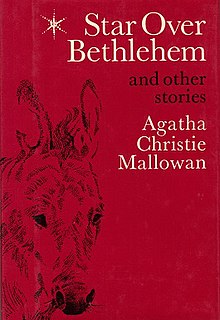Star Over Bethlehem
 Dust-jacket illustration of the first UK edition | |
| Author | Agatha Christie |
|---|---|
| Illustrator | Elsie Wrigley |
| Cover artist | Elsie Wrigley |
| Country | United Kingdom |
| Language | English |
| Genre | Poetry and short story collection |
| Publisher | Collins |
Publication date | 1 November 1965 |
| Media type | Print (hardback) |
| Pages | 80 (first edition, hardback) |
| Preceded by | A Caribbean Mystery |
| Followed by | At Bertram's Hotel |
Star Over Bethlehem is an illustrated book of poetry and
The volume contains five poems and six
Little is known of the reasons for the writing of the contents of this book, however Christie is known to have retained strong religious beliefs throughout her life.[1] She is also said to have been pleased with Collins' plans for the publication and its illustrations by Elsie Wrigley[2] and pleased at the reception of the book and, for once, requests for it to be autographed.[3]
Poems
- A Greeting
- A Wreath for Christmas
- Gold, Frankincense and Myrrh
- Jenny by the Sky
- The Saints of God
Short stories

Star Over Bethlehem
The Naughty Donkey
A boastful donkey refuses to behave or obey the orders of its masters. Having a mind of its own, it leaves whatever master it has and manages to wander through Judea. Sheltering in the stable in Bethlehem, it witnesses the birth of Jesus, the shepherds, the three wise men and the visitation of an angel. Inspecting the presents left by the three wise men for something to eat, the baby Jesus touches the donkey's ear and its character is transformed. It becomes the donkey that takes Joseph, Mary and Jesus into Egypt, once knowing by instinct when Herod's soldiers are near and hiding them.
The Water Bus
Mrs Hargreaves, a middle-aged widow, lives alone in London. Her two grown-up children are married and live far away. She is comfortable on her own but dislikes people, their cares and complaints. She is a generous giver to charity but does not want to be involved herself and feels isolated from everyone around her to the point where even a shopping expedition becomes an ordeal. Craving isolation she takes a
In the Cool of the Evening
Major Rodney Grierson and his wife, Janet, are at
Promotion in the Highest
It is New Year's Eve in the year 2000. In the dead of night, a drunken man, Jacob Narracott, sees a strange procession making its way down the hill from the church. There are fourteen people, among them a woman carrying a wheel (
The fourteen are saints who walk the earth again on their way back to heaven. They stand before the
The Island
On an isolated island, Mary lives with a man who is known to the other islanders as a holy man. This man works at his scriptures desperate for a vision to enable him to complete them. Two men arrive on the island as they have heard that the
(Although not stated implicitly in the story, the island is undoubtedly Patmos where John the Evangelist or John of Patmos wrote the Book of Revelation. John the Evangelist supposedly took care of Mary in her old age but in this story, the positions are reversed, leaving John to complete the final book of the Bible.)
Publication history
- 1965, Collins Crime Club (London), 1 November 1965, Hardback, 80 pp
- 1965, Dodd Mead and Company (New York), 1965, Hardback, 80 pp
- 1991, ISBN 0-425-13229-3
- 1992, Fount Books, October 1992, Paperback ISBN 0-00-627664-4
- 1996, ISBN 0-553-35104-4
The title story was first published in the monthly Woman's Journal issue for December 1946[4]
References
- ISBN 0-00-637675-4
- ISBN 0-00-216330-6
- ^ Morgan. (p. 338)
- ^ Holdings at the British Library (Newspapers – Colindale). Shelfmark: NPL LON 5
